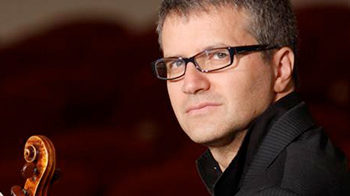by Mike Telin

It would be easy to continually talk about Francesco D’Orazio’s virtuoso technique, impressive bow-arm, spot-on intonation, ability to produce a variety of colors, and understanding of complex musical structures. But he’s too good of a musician for that. It is D’Orazio’s ability to communicate the individualism of each composer’s music that made this one-hour concert so thrilling.
Baroque in structure, Berio’s Sequenza VIII (1976) pays homage to Bach. D’Orazio immediately commanded attention during the work’s powerful opening. In his hands, the soft, muted section was beautiful — like a lullaby. Salvatore Sciarrino’s 26 Capricci (1975) are rooted in the past as well, as they pay tribute to Paganini’s caprices. D’Orazio played Nos. 1 and 4, bringing dramatic life to each of them.
Following an enthralling performances of Ivan Fedele’s Suite Francese II (2010), the violinist showed off his knack for improvisation during Nicola Sani’s Raw (2005). He also exhibited his ability to make a violin sound both like a jackhammer and a circular saw — all within the guise of good musical taste.
The most Baroque-sounding pieces of the evening were Luciano Chessa’s “Sarabanda” and “Corrente” from the Partita (1987-2013). The addition of a chain-link bracelet to D’Orazio’s bow-arm wrist added interesting percussion touches without getting in the way of the beautiful writing and playing.
Based on a Shakespeare sonnet and written for the performer, Curt Cacioppo’s Elegy (2015) is enticingly mournful. D’Orazio’s full-bodied sound, soft trills, and huge pizzicatos portrayed the musical narrative handsomely.
Michele Dall’Ongaro’s musical material for La Musica di E. Z. (1999) was inspired by H.P. Lovecraft’s novel The Music of Erich Zann. The programmatic work opens powerfully — the devil’s fiddle is on fire — and concludes with an epilogue of soft harmonies. A wonderful conclusion to the program.
Acknowledging the large audience’s ovation, Francesco D’Orazio first offered a short piece by Michael Nyman. And then, keeping with the theme of music that is based in the Baroque, something by the master himself, J.S. Bach.
Published on ClevelandClassical.com December 20, 2016.
Click here for a printable copy of this article



